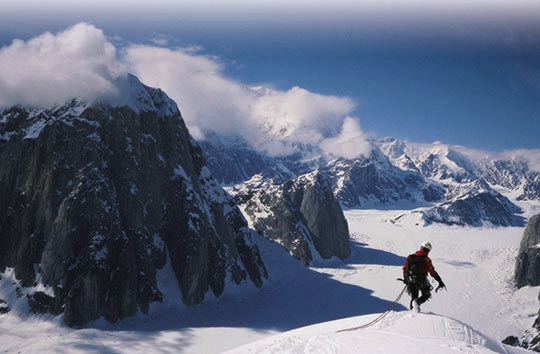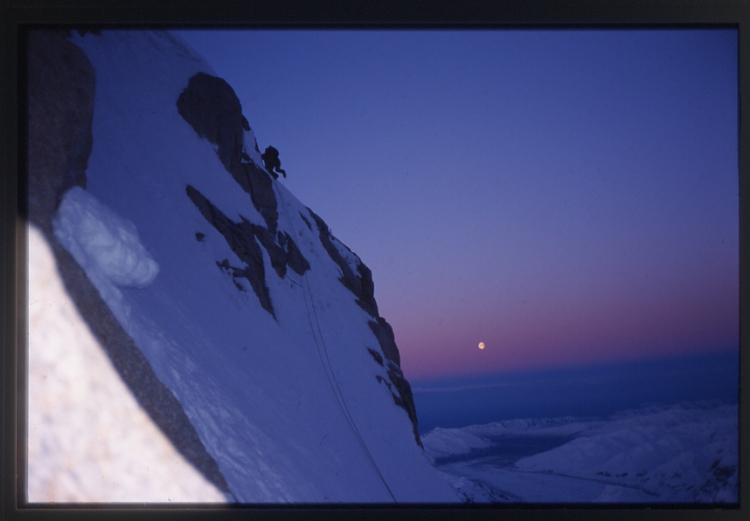A coincidence leads to today’s post, in that yesterday I corresponded with two people who’ve had a powerful influence on me. The first came as a surprise, when Jonathan Waterman, whom I don’t know and haven’t met, but whose writing I’ve long admired, posted the following on my Facebook page:
Just finished The Tower and found it riveting, beautifully written and incredibly researched. An instant classic. Congratulations.”
Some writers, like some climbers, like to claim that they don’t care what anybody else thinks. They do what they do exclusively for themselves. It’s a nice idea, but as an absolute I think it’s usually bullshit. Most of us care what other people think about us and what we do. For me, with the massive, draining, two-plus year effort with my book, praise feels good, especially from people I respect. I’ve received wonderful, surprise compliments from climbing writers I’ve looked up to but didn’t know, such as Dick Dorworth, Lito Tejada-Flores, Jon Krakauer, and David Roberts, all of whom I consider masters of the craft. Roberts reviewed my book in the new AAJ, which intimidated me – his razor-sharp mind and willingness to criticize are traits I admire, and he’s likely our greatest living American climbing writer. But when such a person critiques your work, well, it’s understandable that you might be a bit nervous. The AAJ just came out, and his review is perhaps the highest praise I could have imagined. Blew me away. OK, enough of that.
Soon after Waterman’s note, Jack Tackle and I emailed as he was in the airport, en route to India for an alpine climbing expedition. If you know his history (you can get a glimpse of Jack in this recent Enormocast episode), all he’s done and all he’s endured, you just have to shake your head at his resilience. But it’s more than resilience that makes Jack special to me.
So it dawned on me that awhile back I’d written about both of these guys and the things they’d written. The following originally appeared in January 2008 on alpinist.com, as part of a series they ran on literary influences. Given that I’ve been largely unmotivated to write original stories since my book, I thought I’d post my article here. Feel free to leave a comment about some of your influences – we’re all products of our environments, and I find it illuminating to learn about the influences of others.
Inspirations: High Alaska
High Alaska, the classic from Jonathan Waterman, started it all for me.
But different writings have influenced me in different ways at different times. For me, influence has come from photos, words and people. These have led me to places of inspiration. Photos are obvious: Hey, what’s that, and has this line been climbed? Bradford Washburn was, and still is, the greatest photographer. I can’t imagine that anyone else has influenced and inspired American alpinists the way he has. You always know a Washburn shot when you see one, and I saw plenty of them in High Alaska and the American Alpine Journal.
I can’t remember exactly when I first bought High Alaska, but it was within a month or two of when I first started to climb, the winter of 1993-4, in Missoula, Montana. In May of 1994 I went to Alaska for the first time, aiming for Denali’s West Buttress. I was so inept that the Butt was over my head. Still, it meant everything to me then, at least as much as anything I’ve done since. Even more, all the stories of obscure badass routes and real-deal climbers (unlike me at the time, for sure) inspired me beyond belief. All of my heroes put in their time there. I wanted to be like them.
I’d see something in High Alaska and crave more. More about a specific route. More offshoot conversations sparked by the words and photos. Soon I’d call Gray Thompson (FA of the American Direct on Denali back in 1967, along with a million other great climbs, and a Missoula local) and his wonderful wife, Eloise, to ask if I could come over for a half hour or so to look up something in the AAJ. They’re always generous, and they had all the Journals; their bookshelf was the epicenter of new beginnings for me. My “half hour or so” always became five or six hours, because I’d look at one thing and it would lead to another.
I’ve always loved all climbing periodicals (even those that supposedly make you cooler if you say you don’t like them, evoking the timeless “I’m a hardman” phrase: “aww, I never read them mags”). However, the AAJ was, and I’d like to think still is, in a category all its own. As an aside that I never could have imagined back then, Christian Beckwith, then AAJ editor and co-founder of Alpinist, hired me to be his editorial lackey back in 2000, and I’ve been with the Journal ever since [update: I stopped working there in 2012].

Scott DeCapio descending from London Tower, in Alaska’s Ruth Gorge in 2000, after the first ascent of The Trailer Park, Ruth Gorge, Alaska.
Mark Twight, the undisputed king of rants, has influenced an entire generation or more of alpinists. I first read his story “Twitching with Twight” (in his Kiss or Kill collection) when I moved to Estes Park in 2000, and paid $65 each month to live in a shack. I’d just gotten divorced and struggled hard to get myself together. I had no “real” job, and The Shack was a dump, but it was cheap and two miles from Rocky Mountain National Park—even closer to Lumpy Ridge. Part of me feared I was rolling into a go nowhere, do nothing life, battling with myself over what I loved to do and what I wanted to be rather than following the generic recipe. I love this passage from “Twitching with Twight”:
“Give up this renaissance man, dilettante bullshit of doing a lot of different things (and none of them very well by real standards). Get to the guts of one thing; accept, without casuistry, the responsibility of making a choice. When you live honestly, you can not separate your mind from your body, or your thoughts from your actions.”
The article was over the top—that was the point of it, I think (Mark says so in his Author’s Note after the article)—but some parts hit me hard, with power. The other day, while climbing in the Park, a friend and I talked about this article. It still influences me, even with the little things—when I get self-conscious about my gray hairs and deepening wrinkles around my eyes, this line fires me up to always try my best: “Don’t worry about the gray. If you’re good at what you do, no one cares what you look like.”

Scott DeCapio (L) and I enjoying the good life on the Tokositna after a rapid ascent of Mt. Huntington in 2001.

representing the leisure class in Talkeetna, ca 2000.

Kelly on a rapid, failed attempt at the French Route on Mt. Hunter in 2002. Scott DeCapio photo
One of the greatest articles I’ve ever read is Jack Tackle’s “The Accidental Mentor,” in the Voices from the Summit anthology. It’s an awesome story about an insanely desperate situation, camaraderie, trust, inspiration and the bond of good partnerships.
At one point in the story Jack writes of an evening in Talkeetna, when he finally met Bradford Washburn. Jack was nervous, as meeting one’s heroes can be dangerous: “My lessons with other ‘heroes’ stuck vividly in my mind. In their cases, the book was definitely better than the movie.” Not so when he met Brad, and they talked until 5 a.m. A few hours earlier, Jack, feeling bad about taking up Brad’s time, said he should let Brad get to bed. “I can always go to bed. I can’t always talk to you,” Brad replied. I’ll never forget that line.
Jack wrote of the impact Mugs Stump (from an earlier part of the story) and Brad Washburn had on him: “I am sure they had little or no idea of what influence they had on my life, especially at that time.”
I first met Jack in Missoula, where he gave a slideshow. I’d been climbing for only a year or so, and I watched in awe, taken not only by his accomplishments, but by his overall demeanor and humility. After the show, I wanted to talk to him, but I was afraid—after all, he’s Jack Tackle, and who am I? Finally I summoned the nerve. He made me feel so big, genuinely asking about my life and my climbing ambitions. Jack Tackle! These days Jack and I are good friends. He still inspires me.
When I first poured over the stories in High Alaska and the AAJ, it was just the climbing that made me want to be like those guys. Over time, perhaps I’ve matured a bit, and I feel like I’ve grown into my own person. But, at least when it comes to people like Jack Tackle, yeah, I still want to be like those guys.




